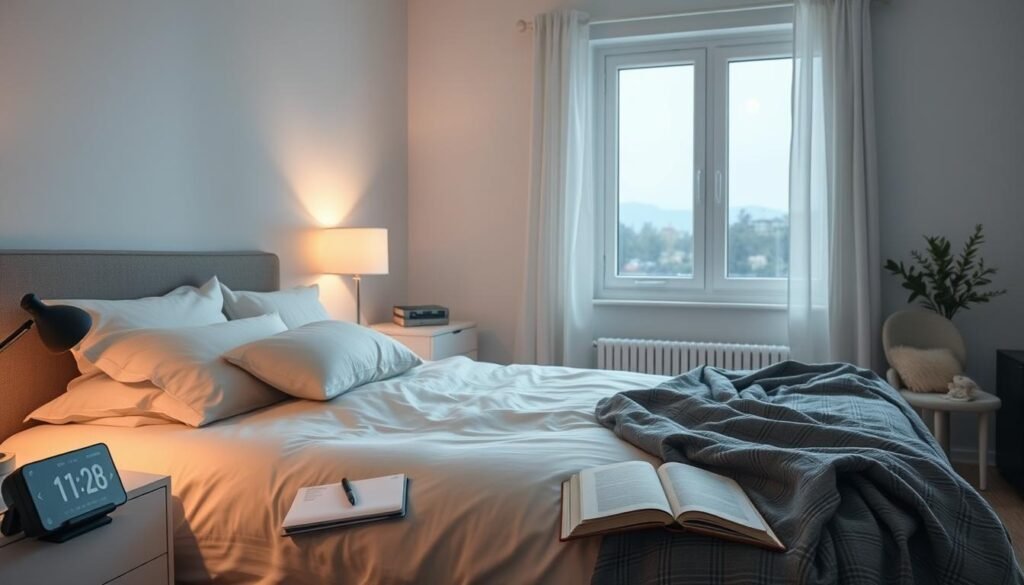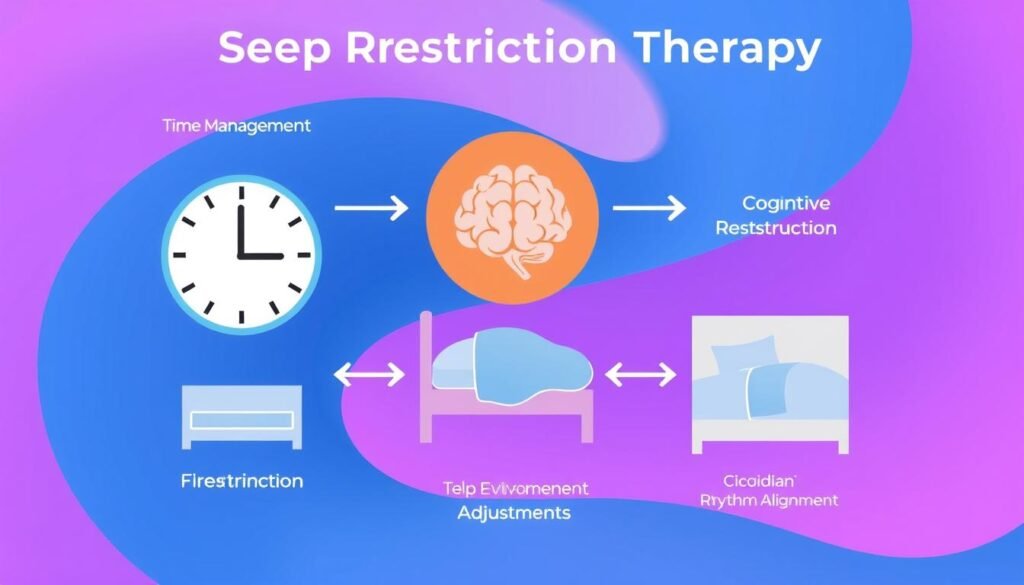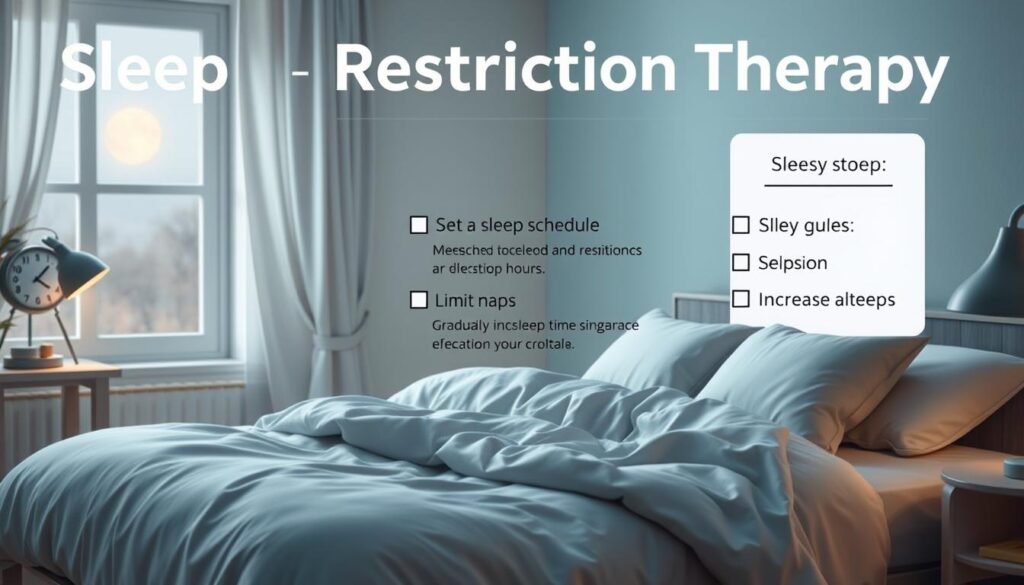Did you know about 33% of Americans have insomnia every year? This fact highlights the need for effective sleep solutions. Sleep Restriction Therapy (SRT) is a top treatment that helps people sleep better. It’s a drug-free approach aimed at increasing sleep quality by managing bedtimes and encouraging healthy sleep routines. This article will explore how SRT works, its benefits, and how to use it to beat insomnia.
Key Takeaways
- Sleep Restriction Therapy is highly effective for improving sleep, particularly for insomnia sufferers.
- Initial steps involve adjusting time in bed to align with average sleep hours.
- Consistent wake-up times are essential for successful implementation of SRT.
- Gradual increases in bed time help individuals discover their optimal sleep duration.
- SRT is a long-term, drug-free solution to enhance sleep quality and efficiency.
- Practical tips, including maintaining a sleep diary, can improve the effectiveness of SRT.
Understanding Insomnia and its Impact
Insomnia affects how well we sleep. It includes having trouble falling asleep, staying asleep, or waking too early. This condition can greatly affect your day. Insomnia definition shows it’s a long-term issue that many Americans face.
What is Insomnia?
Insomnia has different forms but mainly upsets our sleep patterns. People may find themselves awake during the night. This causes lower sleep quality and can harm your physical health.
Prevalence of Insomnia in the United States
Research shows about 33% of Americans battle insomnia yearly. Shockingly, 27% don’t realize they have it. This shows how big a problem insomnia is. Often, it goes untreated, impacting many lives.
Physical and Mental Health Consequences
Insomnia increases the risk of diseases like heart problems and diabetes. It also affects your mind. Many suffer from reduced focus, anxiety, and depression due to poor sleep. This drastically reduces life quality.
Fighting insomnia means knowing its causes and tackling them. Sleep hygiene, relaxation exercises, and spotting symptoms are key. Seeking advice helps manage it effectively. Early recognition is crucial. It helps maintain mental sharpness and daily performance.
What is Sleep Restriction Therapy?
Sleep Restriction Therapy (SRT) is known for helping fix sleep problems. Dr. Arthur Spielman introduced it to tackle insomnia. It has proven to improve sleep by making it deeper and more restful. This is key for folks who find it tough to sleep well.
Origin and Development of SRT
SRT began as a unique solution to insomnia’s complex challenges. Over time, experts have refined it, proving it works well. Various studies have shown it greatly reduces insomnia symptoms. This makes it a trusted method for better sleep.
The Basic Concept Behind SRT
The idea behind SRT might sound odd at first. It involves limiting bed time to make sleep better. By tailoring sleep schedules, SRT seeks to establish a stronger sleep pattern. This approach leads to more quality sleep for those following the therapy.

| Study Year | Findings |
|---|---|
| 2019 | SRT significantly improved sleep among postmenopausal women by reducing maladaptive thinking and hyperarousal. |
| 2021 | Short-term improvements in sleep continuity and insomnia severity observed in individuals with chronic insomnia who followed SRT. |
| Studies 2019 & 2021 | CBT-I, which incorporates SRT elements, markedly enhanced sleep efficiency in clients. |
| General Guidelines | Practitioners recommend not restricting bed time to less than five hours and adjusting time in bed based on sleep efficiency metrics. |
Sleep Restriction Therapy for Insomnia
Sleep Restriction Therapy (SRT) offers a clear path for those battling insomnia. It helps by improving sleep quality. The strategy involves building a strong sleep desire and a steady sleep pattern.
Mechanisms of Action
SRT works by limiting time in bed. This boosts one’s desire to sleep. At first, you get less time to sleep, which makes you more eager to sleep. This approach helps reduce waking up at night, a big problem for insomnia sufferers.
Goals of SRT
The main aims of SRT include:
- Achieving higher sleep efficiency
- Reducing the time it takes to fall asleep
- Increasing total sleep time gradually
Together, these targets aim to normalize sleep habits and enhance sleep quality. About 70% to 80% of people with primary insomnia see improvements with SRT. This shows its effectiveness in bettering sleep.

Comparison of SRT Goals
| Objective | Description |
|---|---|
| Sleep Efficiency | Improving the ratio of sleep time to time spent in bed. |
| Sleep Latency | Making it quicker to fall asleep. |
| Total Sleep Time | Slowly increasing sleep time for better rest. |
With its methods and goals, SRT is a strong choice for improving sleep for those with insomnia.
How Does Sleep Restriction Therapy Work?
Sleep Restriction Therapy (SRT) tackles insomnia by starting with the basics. People follow a set of steps to get their sleep quality up. These steps help in adjusting sleep patterns for better health.
Steps in Implementing SRT
The first move is to keep a sleep journal for one or two weeks. You’ll jot down when you sleep, wake up, and how well you think you slept. After this, you work out your average sleep and bed times. Setting a regular bedtime using this info is key. This builds the base for a healthier sleep cycle. As days go by, you’ll tweak your sleep times based on how efficient your sleep is, aiming for the best pattern.
The Importance of Sleep Journals
A sleep journal is a must-have when you’re starting SRT. It lets you see your sleep habits clearly. You find out what’s working and what’s not. Knowing this helps adjust your sleep better. Keeping track of your sleep throws light on what causes your insomnia. This way, you can plan well to sleep better.

| Step | Action | Purpose |
|---|---|---|
| 1 | Keep a sleep journal for 1-2 weeks | Record sleep patterns and identify habits |
| 2 | Calculate average total sleep time (TST) | Determine baseline sleep needs |
| 3 | Set fixed bedtime based on TST | Establish a consistent sleep schedule |
| 4 | Adjust sleep schedules based on efficiency | Enhance overall sleep quality |
Benefits of Sleep Restriction Therapy for Insomnia
Sleep Restriction Therapy (SRT) has many benefits for those with insomnia. It helps align sleep patterns and tackles sleep issues. This leads to better sleep quality, less anxiety before sleep, and improved sleep efficiency.
Improvement in Sleep Quality
Benefits of SRT include better sleep quality. People fall asleep faster and sleep more soundly. By following a set sleep schedule, they overcome insomnia’s negative cycles.
This leads to feeling refreshed every morning. SRT techniques ensure the sleep you get is of the highest quality.
Reduction of Pre-sleep Anxiety
SRT is key in managing anxiety. A regular sleep schedule reduces worries about not being able to sleep. This reduces pre-sleep anxiety.
Soon, a more relaxed state of mind is achieved. This makes it easier to fall asleep and get restful sleep.
Enhancing Sleep Efficiency
Improving sleep efficiency is another key benefit. SRT focuses on getting quality sleep, not just long hours in bed. This approach reduces lying awake.
It lessens daytime tiredness, helping those with chronic insomnia. Strategies like using sleep journals can lead to better sleep habits.
For more insights on tackling insomnia with sleep restriction therapy, visit this resource.
| Benefits of SRT | Details |
|---|---|
| Sleep Quality Enhancement | Participants report improved sleep onset and extended durations of sleep, leading to feeling more rested. |
| Reduction of Pre-sleep Anxiety | Structured schedules help in managing anxiety around bedtime, creating a more peaceful sleep environment. |
| Sleep Efficiency Improvement | Maximizes quality sleep while minimizing time spent awake in bed, reducing daytime fatigue. |
Potential Risks and Considerations
Sleep Restriction Therapy (SRT) can really help with insomnia. But, it’s important to know the risks and who should be careful with it. For some, SRT might be tough to do.
It’s key to see if SRT is right for you before you start.
Who Should Avoid SRT?
If you have sleep apnea, big mental health problems, or certain illnesses, be careful with SRT. You might need to think twice:
- Patients with untreated sleep apnea
- Individuals experiencing severe mental health challenges
- People with seizure disorders
- Those suffering from major illnesses affecting sleep quality
Talk to your doctor first. It’s very important, especially if you have sleep issues.
Common Side Effects
Adjusting to SRT might have some side effects. Here are a few:
- Increased daytime sleepiness
- Heightened levels of stress
- Irritability as sleep patterns shift
Be extra careful if you work with machines or drive a lot. Knowing these side effects helps make SRT safer and more effective.
| Side Effect | Likelihood of Occurrence | Recommended Action |
|---|---|---|
| Increased daytime sleepiness | Moderate | Limit activities requiring alertness |
| Heightened stress levels | Common | Practice relaxation techniques |
| Irritability | Common | Engage in calming conversations |
Integrating Sleep Restriction Therapy with Other Treatments
Treating insomnia often involves many steps. One effective step is combining Sleep Restriction Therapy (SRT) with Cognitive Behavioral Therapy for Insomnia (CBT-I). This combination helps tackle the problem from both the behavioral and thought-related sides of sleep issues.
Role of Cognitive Behavioral Therapy for Insomnia (CBT-I)
CBT-I works by changing the thoughts and actions that lead to insomnia. It focuses on improving sleep patterns and dealing with negative thoughts about sleep. People using CBT-I fall asleep quicker and sleep more soundly. Studies show they take 19 minutes less to fall asleep and sleep 8 minutes longer.
Complementary Sleep Hygiene Techniques
In addition to CBT-I, adding sleep hygiene techniques to your nightly routine helps. Important steps are:
- Maintaining a consistent sleep schedule.
- Creating a restful sleeping environment free from distractions.
- Regulating light exposure, particularly reducing screen time before bed.
- Utilizing relaxation methods such as deep breathing or mindfulness.
Adopting these practices makes the sleep environment better. It boosts the effectiveness of SRT. For more on improving sleep, check out these sleep hygiene techniques.
Tips for Effective Sleep Restriction Therapy
Sleep restriction therapy works well if you stay committed. It’s essential to keep a regular sleep pattern. Also, make sure your sleeping area is just right. This can greatly help your progress.
Maintaining a Consistent Sleep Schedule
Consistency in sleep is key for this therapy. It’s about having the same bedtime and wake-up time every day. Here are some tips for your sleep schedule:
- Go to bed and wake up at the same time daily.
- Limit naps during the day, especially in the afternoon.
- Gradually adjust the bedtime if required, based on efficiency in sleep.
These habits help your body’s clock stay on track. And they lead to better sleep, making therapy more effective.
Creating an Optimal Sleep Environment
Having the right conditions for sleep is crucial. A good sleep area helps you rest better. This makes sleep restriction therapy more likely to work. Here’s how to set up your room:
- Ensure the bedroom is dark, cool, and quiet.
- Minimize noise disruptions using earplugs or white noise machines.
- Maintain comfortable bedding that supports a good night’s sleep.
Making these changes means fewer distractions. It allows you to stick to therapy suggestions better. For extra info on sleep restriction therapy and its advantages, check out this resource.
Conclusion
Sleep Restriction Therapy (SRT) is a great way to help people with insomnia. It works by increasing sleep pressure and lowering arousal. This helps people who find it hard to sleep at night. A study shared on this website talks about how good SRT is for treating insomnia.
Those dealing with insomnia can really benefit from SRT. It not only makes sleep better but also boosts well-being. At the start, it might make you more sleepy during the day. But this shows it’s working. This method gives people the chance to take charge of their sleep again. It builds a strong base for fighting insomnia.
Taking on SRT can change how well you sleep in a big way. It helps you meet your sleep goals more easily and effectively. By getting to know and using SRT’s steps, you could get back the good sleep you’ve been missing. This makes way for a brighter, more active life.